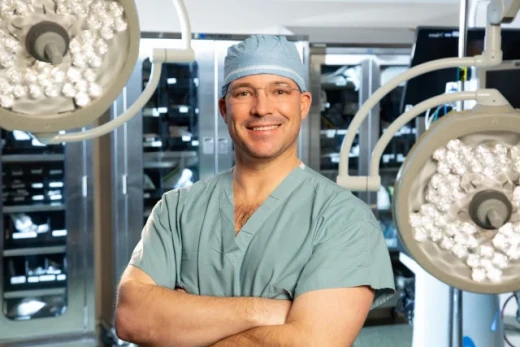
AL.com
Benton A. Emblom, M.D.
Athletes continue to become more serious about their sports earlier in life, and those athletes remaining serious about their sports continues on for longer than ever before. Sports medicine physicians face the challenge of diagnosing and treating athletes faster and more efficiently as well. The stakes may be the fate of an entire college team, the future of a high school standout, or the sheer joy of a middle-aged competitor. The sports hernia is an interesting example of an injury that afflicts high-power athletes, which several decades ago had no diagnosis or treatment at all. In the past decade, surgeons have developed a solution that uses one incision and yields a 95% recovery rate.
You may be rightly confused about hernias being particularly associated with high-level athletes. The only reason a “sports hernia” was ever called such is because the pain manifests in a similar abdominal/groin area to what we recognize typically in the case of a true hernia. The sports hernia not a really a hernia, which is a weakness in the abdominal wall marked by a visible protrusion. According to Dr. Benton Emblom, a founding member of The Hip Center at Andrews Sports Medicine, a sports hernia is “an injury in which athletic moves generate enough muscular force, in an acute moment or over time, to fray an adductor/abdominal tendon’s investing fascia (where they meet) with the pelvis bone.” To clarify, he said, “Imagine someone like Julio Jones or Trent Richardson— powerful legs, great speed—making a sudden cut against all of his momentum. Their adductors (inner-thigh muscles) stabilize the knee and the abdominals stabilize the trunk simultaneously to achieve a lateral reversal of movement—the better the cut, the more repetitions, the more force.” Emblom would know firsthand, as he is one of the team physicians for the University of Alabama Crimson Tide football team.
According to Dr. Emblom, the sports hernia has long been diagnosed in general practice as a groin strain. He doesn’t say this to criticize general physicians—there are, of course, more serious consequences to an athlete who is misdiagnosed or waits until the pain is unbearable rather than, say, a journalist. Sports careers have been cut short by this injury, which begins as nagging pain during exertion and becomes debilitating through subsequent attempts at rest and recovery. Out of necessity, sports surgeons developed a specific diagnostic procedure tissue-sparing surgery on the area over the last decade. Today, 95% of athletes who have this procedure return to their sport. Movement can resume in as little as four to six weeks, while they can be back at their sport full speed within three months.
The Procedure
As a precaution against unnecessary surgery, the patient often undergoes several weeks of physical therapy and assessment, including MRIs and soft tissue tests. Emblom said that in general, 1 in 10 patients may not have a true sports hernia requiring surgery.
Usually scar tissue has developed around a tear on the adductor part of the fascia. The rectus abdominis has started to pull away as a result. There are two major points to the surgery which takes just one small incision and around an hour to perform:
1. Completing the existing adductor tear, with a “limited release.”
2. Folding the tissue from that release back upon the abdominal tendon insertion in order to reinforce the area.
The adductor can tolerate this limited release because it is but one small member in a supporting cast of four muscles. Further, the adductor tendon regenerates well from this release and is often unnoticeable on later MRIs. In just four to six weeks, athletes can return to some light practice work. Tendons do take a minimum amount of time to heal completely, so full practice cannot resume until three months after surgery.
When asked if this is “as good as it gets” for treatment, Emblom replied, “The minute you think that in this profession, you get passed by—every day an athlete is off of the field is problematic to us. And it doesn’t end with a successful short-term recovery. We are gathering valuable research in-house [at Andrews] to contribute to the understanding of long-term outcomes.” In reviewing over 100 surgeries performed at Andrews, one thing Emblom has noted is that patients who had undergone prior suboptimal surgeries did not perform as well upon their return. This may help clarify other research which has recently shown that athletes who have had sports hernias had shorter NFL careers than those who did not. Emblom hypothesizes that these late-career athletes had possibly undergone other surgeries before the current procedure was optimized. He himself has never had an athlete re-tear the repaired side.
As for protocol for decreasing the likelihood of sports hernias, they involve maintaining balanced training and avoiding placing undue stress on the tendons. Emblom has successfully lowered the rate at The University of Alabama. But since this is a tendon injury, there is no real means to “condition away” the risk. As seasons get longer and athletes place more stress on their tendons, which take months to heal, sports hernias will continue to exist as an issue.
For more information about treatment and rehabilitation associated with sports hernias and other sports-related injuries, visit andrewssportsmedicine.com.







